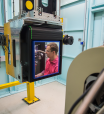Window into the cell
Access to a ‘window into the cell’ with University of Wollongong cryogenic electron microscope at ANSTO.

Showing 101 - 120 of 509 results
Access to a ‘window into the cell’ with University of Wollongong cryogenic electron microscope at ANSTO.
Chinese researchers have eveloped a novel strategy for the scalable production of high-performance, thin, and free-standing lithium anodes for lithium-ion batteries with enhanced cycling stability and electrochemical properties.

The User Advisory Committee (UAC) are pleased to present this year's invited speakers.

New international limits on the cadmium content of cacao products have spurred research to discover how cadmium accumulates in cacao beans, and the effects of processing.

The mechanical, electrical, chemical, optical and thermal properties of glass, as determined by its chemical composition and atomic structure, make it a highly useful material with a myriad of applications.
Two ANSTO physicist explain the three-body problem as featured in science fiction series of the same name
ANSTO provides secondary students with a range of learning resources for those interested in science or studying for exams. For teachers, ANSTO provides learning resources and professional development, as well as in-school-term science tours and videoconferences. Workbooks are provided as required learning material to accompany a school visit to ANSTO. They can also be used on their own as a classroom resource.

ANSTO expertise focused on understanding of reduced water levels at Thirlmere Lakes in three year collaborative project

Highlights of the Energy Materials Project.
Research demonstrates the existence of hexagonal planar geometry in a transition metal complex with great potential application across multiple disciplines.
Using nuclear techniques to help sustain Australia's finite groundwater resources
Three-year full-time PhD program is in partnership between the nandin Innovation Centre (ANSTO) and Design Factory Melbourne (Swinburne University). The PhD is based at ANSTO, Lucas Heights, Sydney, NSW.

The High Performance Macromolecular Crystallography beamline will enable the study of very small (sub-5 micrometre) or weakly diffracting crystals, providing a state-of-the-art high-throughput facility for researchers. MX3 will be able to study the structures of large proteins and protein complexes for virology, drug design and industrial applications via goniometer mounted crystals, in-tray screening, or via serial crystallography methods.

The instrument is designed to measure inelastic neutron scattering, or do neutron spectroscopy.

Radioisotopes are widely used in medicine, industry, and scientific research. New applications for radioisotopes are constantly being developed.